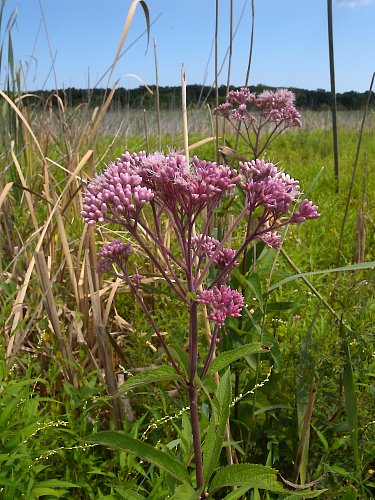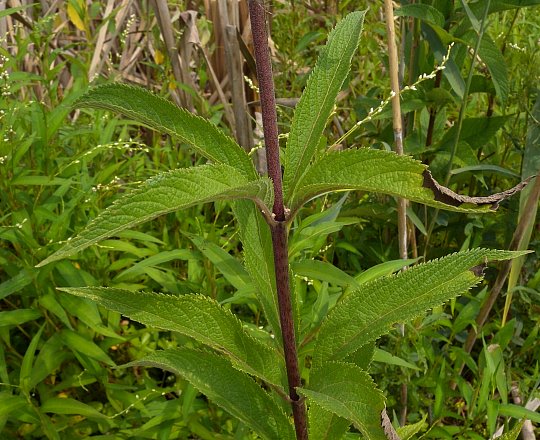Description: This perennial plant is 3-5' tall and unbranched, except for flowerhead-bearing stalks near the apex of the plant. The central stem is stout, terete, and either purple-spotted or purple; it is often covered with short fine hairs. At intervals along the central stem, there are whorls of 4-5 leaves that are yellowish green or green. These leaves are up to 7" long and 2½" across; they are lanceolate to broadly elliptic and serrated along their margins. The upper leaf surfaces have conspicuous venation. The petioles of the leaves are short (less than ¼" in length). The central stem terminates in a rather flat-headed panicle of flowerheads spanning 3-6" across. Small clusters of flowerheads may occur below on separate stalks. Each narrow flowerhead is about 1/3" (8 mm.) long, consisting of 8-20 pink to purplish pink disk florets and no ray florets. Each tiny disk floret has a narrowly tubular corolla with 5 spreading lobes along its upper rim; exerted from the corolla, there is a strongly exerted style that is divided into filiform parts. The narrow bracts (phyllaries) at the base of each flowerhead are pink or purplish pink, like the disk florets. The flowering stalks are purple-spotted to purple and they are often covered with short fine hairs. The blooming period occurs from mid- to late summer, lasting about 3-4 weeks. The flowerheads are often fragrant. The florets are replaced by achenes with small tufts of bristly hair; they are dispersed by the wind. The root system is fibrous and rhizomatous. This plant often forms small clonal colonies.

Cultivation:
The
preference is full or partial sun, wet to moist conditions,
and a mineral-rich soil containing silty or sandy loam. Spotted Joe-Pye
Weed is more tolerant of water-logged conditions than most plants.
Range & Habitat:
The native Spotted Joe-Pye Weed occurs occasionally in the northern
half of Illinois, while in the southern half of the state it is rare or
absent (see Distribution
Map). Habitats include wet black soil prairies, wet
sand prairies, sedge meadows, marshes, fens, and swampy thickets with
small trees or shrubs. Spotted Joe-Pye Weed is partial to sandy
wetlands, but it is also found in non-sandy wetlands. It is usually
found in high quality natural areas, rather than degraded habitats with
a history of disturbance.

Faunal
Associations:
The nectar of the flowers attracts honey bees, bumblebees, long-horned
bees (Melissodes spp.),
leaf-cutting bees (Megachile
spp.), bee flies, butterflies, skippers, and
moths. Some bees may also collect pollen. The following leaf beetles
have been observed to feed on Spotted Joe-Pye Weed: Exema dispar, Ophraella notata,
and Sumitrosis
inaequalis (Clark et al., 2004). An uncommon aphid, Aphis vernoniae,
sucks the plant juices. The caterpillars of some moth species feed on
various parts of Eutrochium spp. (Joe-Pye
Weed species). They include Schinia trifascia
(Three-Lined Flower Moth; feeds on florets), Carmenta bassiformis
(Eupatorium Borer Moth; bores through roots), Phragmatobia fuliginosa
(Ruby Tiger Moth; feeds on foliage), and Eupithecia miserulata
(Common Pug; feeds on florets). The seeds of Joe-Pye Weed species are a
minor source of food to the Swamp Sparrow. The foliage
is not preferred as a food source for mammalian
herbivores, although it may be browsed upon occasion by deer,
rabbits, or livestock.
Photographic Location: Cowe's Bog at the
Indiana
Dunes National Lakeshore in NW Indiana. Cowe's Bog is a sandy fen.

Comments: Recently, species of Joe-Pye Weed have been separated from the Bonesets (Eupatorium spp.); they have been re-assigned to the genus Eutrochium. Some sources of information still refer to this species as Eupatorium maculatum, and sometimes it is also referred to as Eupatoriadelphus maculatus. In Illinois, species of Joe-Pye Weed differ from the Bonesets by their whorled leaves, while the latter group of plants usually have opposite leaves. Spotted Joe-Pye Weed (Eutrochium maculatum) differs from Hollow-stemmed Joe-Pye Weed (Eutrochium fistulosum) and Sweet Joe-Pye Weed (Eutrochium purpureum) by its rather flat-headed panicles of flowerheads, purple-spotted or purplish stems that are often pubescent, and flowerheads consisting of 8-20 disk florets. Other species of Joe-Pye Weed within the state have more dome-shaped panicles of flowerheads, stems that are hairless, and flowerheads consisting of 4-7 disk florets. Spotted Joe-Pye Weed also tends to be shorter.